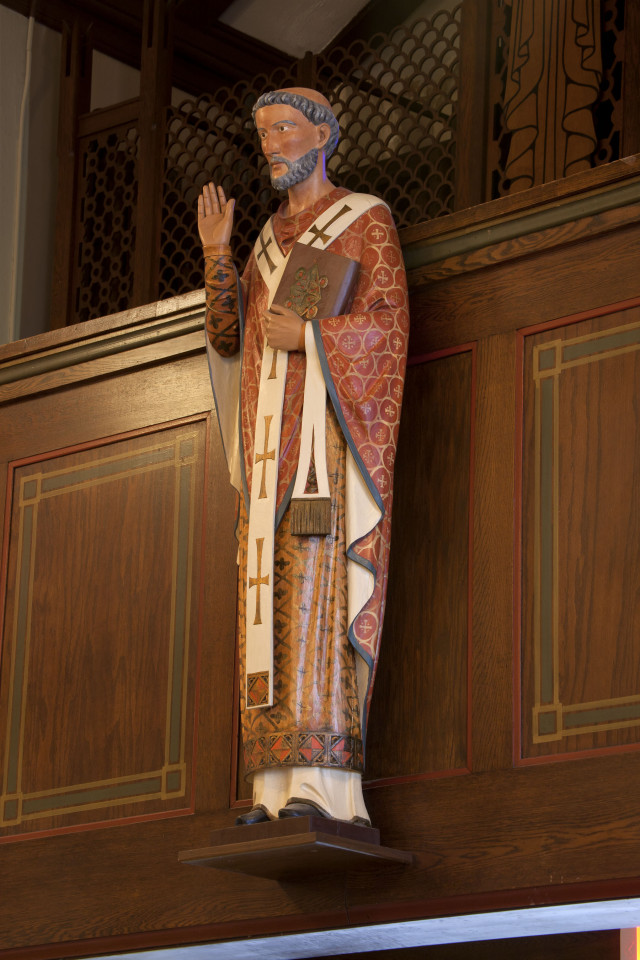Located North Quadrant in front of Choir Loft
Year Built 1922 Donated by Clement H. Satink
Saint Clement Pope and Martyr (Our Patron Saint)
This statue was originally hung over sanctuary in the 1931 renovation and moved to the choir loft during the 1968 renovation.This statue sits on a beautiful pedestal and was carved from wood at Oberammergua, Bavaria, Germany known for its woodcarvers. It was decorated in the studios of Rambush Decorating Company to conform with the entire decorative scheme reminiscent of the Early Church. (ArchivesLakewood
Centennial Church Tour July 30, 1989).
Pope Clement I
Starting in the 3rd and 4th century, tradition has identified him as the Clement that Paul mentioned in Philippians 4:3, a fellow laborer in Christ who later became Pope under the Emperor Domitian. His zeal for the propagation of the Faith prompted him to preach incessantly. He divided the city of Rome into seven districts and appointed in each district a scribe whose duty it was to search out and record the heroic virtues and sufferings of the martyrs in their district, so that these edifying accounts might be read publicly at the meetings of the Early Christians.
His teaching and the holiness his life brought many to believe in Christ, notably members from the Emperor’s own household and he was therefore exiled by the emperor Trajan to Kherson, in the Crimea, where he found 2,000 Christians who were condemned to death by the same Trajan. Here he was forced to work in the marble quarries. During their labor they suffered for want of water and according to accounts,
Clement prayed and then went up a hill nearby, on the top whereof he saw a lamb standing, touching with its right foot a flowing spring of sweet waters. By this miracle many unbelievers were brought to believe in Christ and began to honor the holiness of Clement.
These things led Trajan to send a messenger into Crimea, who tied an anchor about Clement’s neck and cast him into the depth of the Black Sea. After it had been done while the Christians were praying on the shore, the tide receded for three miles, and when they followed it they found a divinely built shrine of marble which held the body of the Saint and near by the ancho wherewith he had been sunk. For many years his
remains rested within this miraculously constructed shrine beneath the waves, and year after year the tide would recede three miles to enable the Christians to visit his tomb. The body of St. Clement was brought to Rome in the time of Pope Nicholas I, and buried in his own church. A church was built in his honor at the site in Crimea where God miraculously supplied the water in answer to the prayers of the saint.
St. Clement of Rome, whose name we hear recalled the First Eucharistic Prayer of the Roman Canon, was an important figure in the early Church, both as a martyr for the Faith and as the Bishop of Rome. His feast day is November 23 and he often depicted in art with a fish and an anchor. Thus the patron saint of our church which honors him for his zeal for the propagation of faith, his untiring labors in behalf of the suffering poor, his patience and courage in the face of difficulties and dangers, his readiness to accept the cross of martyrdom these
shall ever be the efficient source of inspiration and encouragement to the members of St. Clement’s church to continue the good work began in 1922.
Dedication prayer in honor of St. Clement (Dedicated by Most Joseph Schremba, DD., Bishop of Cleveland, January 17, 1932
“Oh God, Who year by year dost gladden us by the solemn feast day of Thy blessed Martyr and Pope, St. Clement, mercifully grant that we who keep his birthday, may copy that manly strength which he showed under his sufferings. Through our Lord, Jesus Christ Thy Son, Who liveth and reigneth with Thee, in the unity of the unity of the Holy Ghost, world without end. Amen.”
(Archives of St. Clement’ Parish, The Story of Foundation and Growth, April 27, 1922 September 16, 1923)


